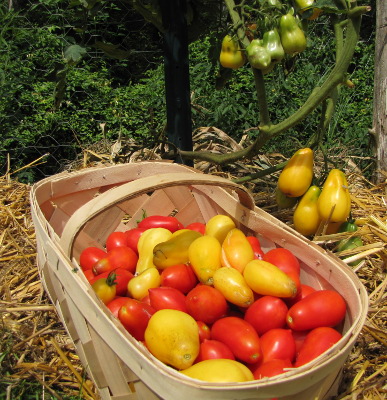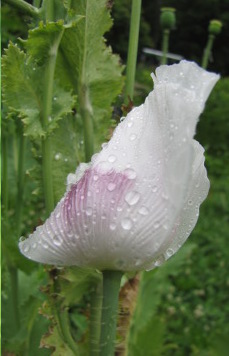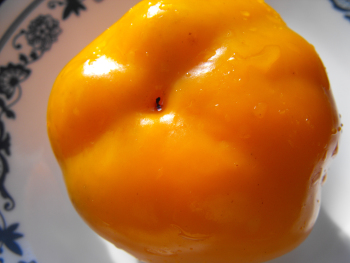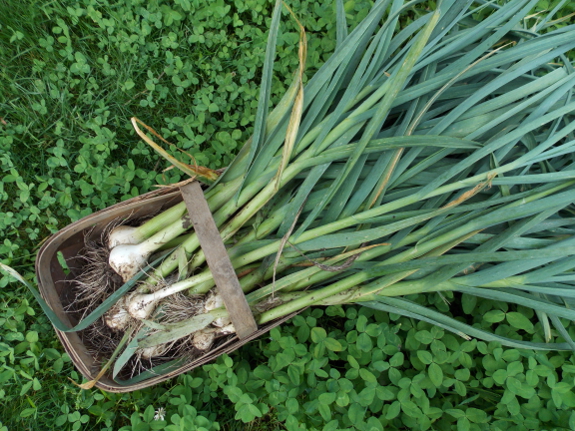
Walden Effect approved vegetable varieties
 "What are your favorite varietals, the veggies you MUST plant every year?
You should do a lunch time series on all the types that work best in
our region!"
"What are your favorite varietals, the veggies you MUST plant every year?
You should do a lunch time series on all the types that work best in
our region!"
I kept thinking I'd
posted about this before, but then I realized that even if I did post
three years ago, chances are my answer would be different now.
(Plus, January is a good time for garden porn.) So, without
further ado, here are the varieties I always plant (in order of planting date):
Lettuce --- Black-seeded Simpson. Somewhat boring, green leaf lettuce, but it just works.
 Onion --- Pontiac F1. This is the first year our onions have really worked,
and only our second year growing Pontiac, so I'm not 100% resolved to
never try anything else. But for now, Pontiac makes me happy.
Onion --- Pontiac F1. This is the first year our onions have really worked,
and only our second year growing Pontiac, so I'm not 100% resolved to
never try anything else. But for now, Pontiac makes me happy.
Poppy
--- Hungarian Breadseed. Not that I've grown any other kind of
poppyseeds. And I'm not really 100% sure that I'm really growing
Hungarian Breadseed --- the picture on the package has a blue flower and
these flowers are closer to white. But they make good poppyseeds and I keep saving some for future years' gardens.
Broccoli
--- Packman Hybrid. Although, I'm not actually planting this
variety this year since Johnny's doesn't carry it and I think I'm
sticking to one seed order for the spring planting. But when I
order from two places, Packman is the best broccoli.
Swiss Chard --- Fordhook Giant. This is the most freeze-resistant chard.
 Pepper --- Tangerine Pimento.
I grow this pepper because I'm too lazy to start peppers inside many
years, and it's fast enough to turn orange before frost.
Pepper --- Tangerine Pimento.
I grow this pepper because I'm too lazy to start peppers inside many
years, and it's fast enough to turn orange before frost.
Cucumber
--- Harmonie F1. We love these cucumbers because they don't die
as quickly as other cucumber plants in our troublesome climate, they are
awesome for fresh eating, and they're very prolific. Diamont
Hybrid was just as good, but was replaced by Harmonie. I'm working
on dehybridizing this variety since hybrid cucumber seeds are expensive
(and, as you can see, the companies change them quickly).
Watermelon
--- Sugar Baby. This is starting to sound like a theme, but I
grow Sugar Baby because it doesn't get diseases as badly as some other
watermelons and the fruits are small so they ripen before the vines
die. In other words, I'm a lazy gardener and Sugar Baby works.
 Green bean --- Masai. These tiny green beans are the tastiest possible, and are a staple for both summer and winter (frozen).
Green bean --- Masai. These tiny green beans are the tastiest possible, and are a staple for both summer and winter (frozen).
Tomatoes
--- Martino's Roma and Yellow Roma for sauce and drying and soup, Crazy
and Blondkopfchen for nibbling, Stupice for early and dependable
slicing. These are all chosen primarily for blight-resistance.
Okra --- Clemson Spineless. We haven't tried a lot of different varieties, but this one is good, so I stuck to it.
Sweet potatoes --- Beauregard. Same as for okra (and many of the other vegetables listed above). When you save your own seeds (or make your own slips), if a vegetable variety works, you have no reason to change it. No, I don't tempt myself by reading seed catalogs.
Squash --- Butternuts and Yellow Crookneck. They survive the borers and are delicious.
Kale --- Improved Dwarf Siberian and Red Russian. These win for winter flavor and frost hardiness.
 Asian greens --- Tatsoi and Tokyo Bekana. These aren't as much staple greens as kale is, but they are fun to have around.
Asian greens --- Tatsoi and Tokyo Bekana. These aren't as much staple greens as kale is, but they are fun to have around.
Garlic
--- Music, Italian Softneck, and Silverwhite Silverskin. These
are troopers, but I'm not convinced other varieties are any less good.
Anything I didn't list
above, we either don't grow, or I haven't settled on a solid favorite
variety (or I missed it while browsing my spreadsheet). Vegetables
in the undecided-variety category that come to mind are cabbage,
carrots, and corn.
What varieties do you swear by in the garden?
Want more in-depth information? Browse through our books.
Or explore more posts by date or by subject.
About us: Anna Hess and Mark Hamilton spent over a decade living self-sufficiently in the mountains of Virginia before moving north to start over from scratch in the foothills of Ohio. They've experimented with permaculture, no-till gardening, trailersteading, home-based microbusinesses and much more, writing about their adventures in both blogs and books.
Want to be notified when new comments are posted on this page? Click on the RSS button after you add a comment to subscribe to the comment feed, or simply check the box beside "email replies to me" while writing your comment.

Since you're ordering from Johnny's, I highly recommend the Bolero carrot (pelleted for easy spacing) for your storage carrots. They were gorgeous and have (thus far) stored beautifully in damp sand in my insulated garage.
My favorite green bean though is Rattlesnake pole, and I eat 75% of them raw: so sweet!
If I had to pick only one carrot (though we grow 5 varieties!) to grow it would be the heirloom, St. Valery. I still have the carrots in the ground, and regularly harvest them as needed. The freeze from the polar vortex killed most of the green vegetation, but seems to have improved the crunch and sweetness of the carrot. The green top growth is already returning, and they seem to be just fine. They haven't split yet, and are of nice size. I plan to keep them in the ground until spring, and to continue monitoring their eating ability on a weekly basis. Oh, and we are in zone 6B (Central Kentucky).
zone 4. Gilbertie Paste in tomato. Butternut squash (nutterbutter or any of the main varieties). Costa Romanesco zuch. I shred it and dry it and shred it and freeze it. Dried goes into fritters and bread. Frozen goes into hot dishes and not-lasagna.
Nantes carrot. It grows. It stores. It doesn't split out on me.
Orach - either color. It is our summer staple for "green stuff on sandwich next to meat"
Tuscan kale. no bugs, no hassle.
Like above - still working on varieties for beans, peas, corn, etc.
I'd like to recommend a few varieties to you. I live in Midwest zone 5, and it's hot and humid during the summer. Through trial and error, these have done consistently well for me.
Lettuce: Crisp Mint (romaine type, slow to bolt, and never seems to get bitter)
Watermelon: Blacktail Mountain (icebox size, really sweet, and ripe in only about 75 to 80 days!)
Cucumber: Japanese Long, grown on a trellis (good producer, small seeds, kind of like an english cucumber, I eat the skin too)
I have saved heirloom varieties for years. I'm in Utah so I'm not even close to your growing conditions. I found this website from someone near my growing area that plants several varieties and lets them cross pollinate to their best for the growing zone they are in. I am going to try it with some of my seeds this year. He doesn't care if they are heirloom or hybrid. He just mixes them all and finds the best for his area. He adds varieties later to keep the new mix going. I always tried to keep my seeds pure, but now wonder why I try to get the best tomato in the desert when it was originated in a completely different zone.
http://garden.lofthouse.com/adaptivar-landrace.phtml